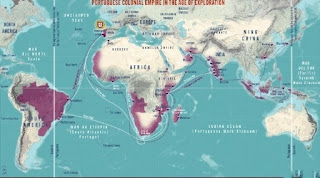In ancient times, trade relations between Europe and India began with the Greeks. In the medieval period, Europe's trade with India was carried out through several routes.
Trade routes :
◆ One route was by sea to the Persian Gulf. From there it went by land through Iraq and Turkey and further by sea to Venice and Geneva.
◆ Another route was by land to Alexandria in Egypt via the Red Sea and thence by sea to Venice and Geneva.
◆ A third, but less common, land route passed through the rates of the North-West Frontier Province of India, crossing Central Asia, Russia, and the Baltic Sea.
Thus There were two main sea routes connecting India to Europe - the first through the Persian Gulf and the second through the Red Sea, with the Persian Gulf route being the more common, as the Red Sea route was difficult due to heavy fog.
 |
| Trade route |
Arabians' Dominance
Much of Asia's trade was in the hands of Arabs, while Mediterranean and European trade was monopolized by Italian merchants. This trade was very important because of the hot spices of the eastern countries, as hot spices were in great demand in Europe. These spices were very expensive in Europe because they survived on salt and pepper-laden meat in winter.
In 1453, Kustuntunia was conquered by the Turks, who also lost the route connecting the east and the west, and refused to allow European merchants to trade with the east through their empire.
European trade affected :
Earlier, the merchants of Venice and Geneva had monopolized the trade between Europe and Asia, due to which the new nations of Europe, Spain and Portugal, were excluded from trade, but due to the importance of hot spices and the greed of the famous glory of India, they started trading with the East. They were eager to do this.
That is why the new states of Western Europe started looking for new and relatively less risky routes to reach the spice islands of India and Indonesia. These people wanted to break the monopoly of Arab and Venice traders and establish direct trade relations with the eastern countries by avoiding conflicts with Turkey.
Technological advances :
They were well able to do this because great advances were made in shipbuilding and navigation science during the 15th century. The European Renaissance created a spirit of enterprise among the people of Western Europe. At this time the Qutubnuma (direction indicator) had also been invented. Portugal was instrumental in discovering new geographical discoveries and trade routes. The task of geographical discoveries was facilitated by the continuous efforts of Prince Henry "the Navigator" of Portugal.
Era of Discoveries : Reached to India
The Portuguese and the Spaniards began an era of geographical discoveries. The Portuguese navigator Bartholomaeus discovered the Uttamasha Antripa, which he called the Stormy Antripa, in 1487 CE.
In 1494, Columbus, a Spaniard, discovered the Americas while searching for a route to India.
In 1498, the Portuguese Vasco da Gama succeeded in reaching India by circumnavigating the Uttamasha range. The sole purpose of all these innovations was to gain knowledge of trade routes and to make economic profits.
Famous ports were Calicut and Cochin on the Malabar Coast in the west of India, and Surat, Bharuch, and Cambay in Gujarat. These ports were major centres of Indian trade with western countries.
Major exports :
Southeast Asia's spices, silk, ceramics, lac, etc. were brought to the Malabar Coast, from where they were shipped to western countries via the Red Sea and the Persian Gulf.
Other major Indian exports to the West were cotton textiles, indigo, spices, and herbs. At this time, a large quantity of cotton cloth was exported from Gujarat. Around 1500 CE, the dominant community controlling the entire trade of India was the Coromandel Chettiar community. They played a major role in the trade across the Bay of Bengal region and especially from the Coromandel to Malacca.
Joining them in this trade was another south-eastern merchant community, the Chulia Muslims. Thus specific sea routes were dominated by specific trading communities at the time of the arrival of the Portuguese in India.
Order of Coming of European Companies :
The first Europeans to arrive in India were the Portuguese. This was followed by the Dutch, the English, the Danish and the French. Among these Europeans, although the British succeeded the Dutch, their East India Company was already established before the Dutch East India Company.








